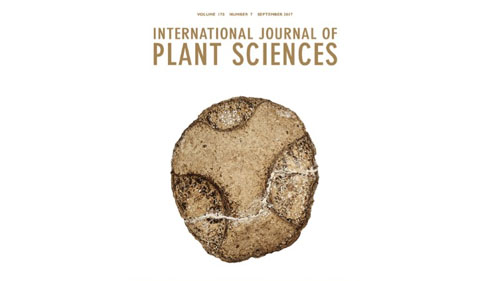
Brian Atkinson
Research by Ohio University alumni Brian Atkinson ’12 and Dr. Ruth Stockey ’74 along with Dr. Gar Rothwell was featured on the cover of the September 2017 issue of International Journal of Plant Sciences.
Their article is titled “The early phylogenetic diversification of Cornales: permineralized cornalean fruits from the Campanian (Upper Cretaceous) of western North America.”
Atkinson, the lead author on the article, earned a B.S. in Environmental Biology from the College of Arts & Sciences. He earned a Ph.D. from Oregon State University’s Department of Botany and Plant Pathology, where he studied the evolution of flowering dogwood plants using fossils from the Late Cretaceous period of Japan and Western Canada. He is now a post-doc in the Department of Ecology and Evolutionary Biology and Biodiversity Institute at the University of Kansas. Connect with Atkinson on LinkedIn.
Rothwell is Distinguished Professor Emeritus of Environmental & Plant Biology.
Stockey earned an M.S. in Plant Biology from the College of Arts & Sciences at Ohio University. She is Professor of Botany and Plant Pathology at Oregon State University.

Cover of the International Journal of Plant Sciences featuring permineralized cornalean fruit
Abstract
Premise of research. Two permineralized fruits have been found within a single calcareous concretion from the Upper Cretaceous (upper Campanian) Spray Formation of Vancouver Island, British Columbia. These fossils provide additional evidence for the initial phylogenetic diversification of Cornales, the earliest diverging asterid lineage.
Methodology. Specimens were prepared using the cellulose acetate peel technique.
Pivotal results. A new cornalean species, Suciacarpa xiangae sp. nov., is characterized on the basis of a well-preserved fruit specimen. This fruit is represented by a large ovoid tetralocular sclerenchymatous endocarp. Locules are crescent shaped in transverse section and accompanied by short dorsal germination valves. Valves consist of small isodiametric sclereids as well as a large number of large secretory cavities. The septum and central axis are composed of transversely oriented and interwoven fibers and elongate sclereids. There is no major central vascular bundle; however, there are numerous small bundles scattered within the septa. This fruit has one apically attached seed per locule. An additional cornalean taxon—Sheltercarpa vancouverensis gen. et sp. nov., also represented by a single smooth tetralocular sclerenchymatous endocarp—consists of isodiametric and a few elongate sclereids, with short germination valves, one seed per locule, and lacks a central vascular bundle.
Conclusions. Because of unique combinations of characters, the two fruits described in this study represent two new cornalean taxa, S. xiangae sp. nov. and S. vancouverensis gen. et sp. nov. These fruits display mosaics of apomorphic and plesiomorphic characters that occur in families of at least two different major cornalean clades: Cornaceae/Alangiaceae and Nyssaceae/Mastixiaceae/Davidiaceae. The morphological diversity seen in these taxa and other cornaleans from the Late Cretaceous suggests that the Campanian was an important time for the initial phylogenetic diversification of Cornales.



















Comments